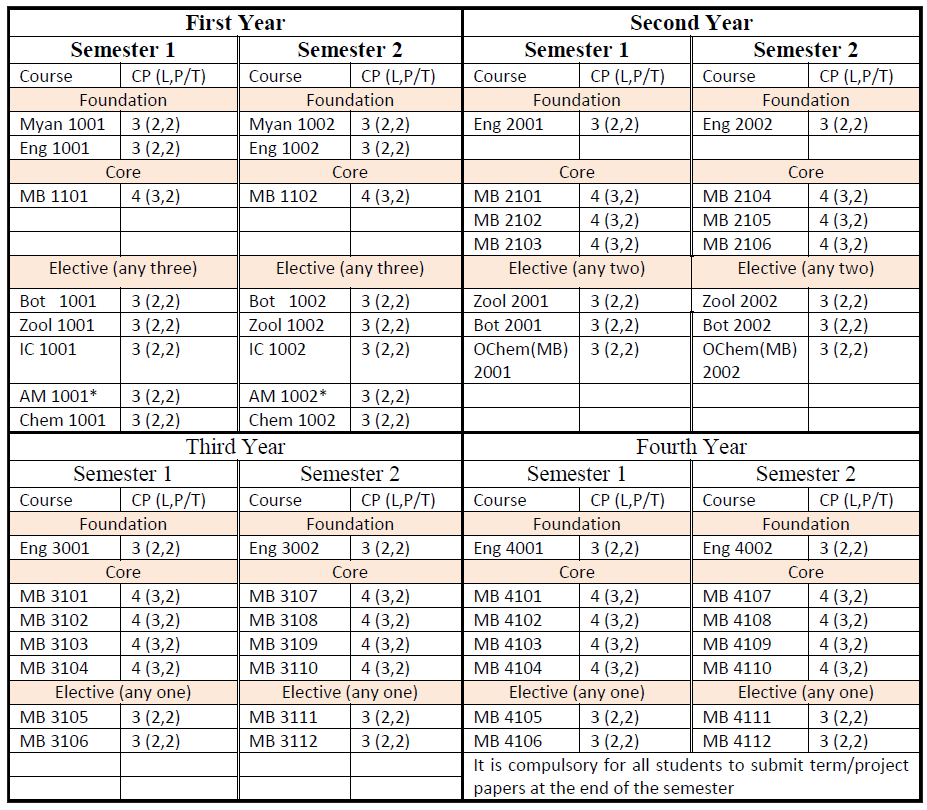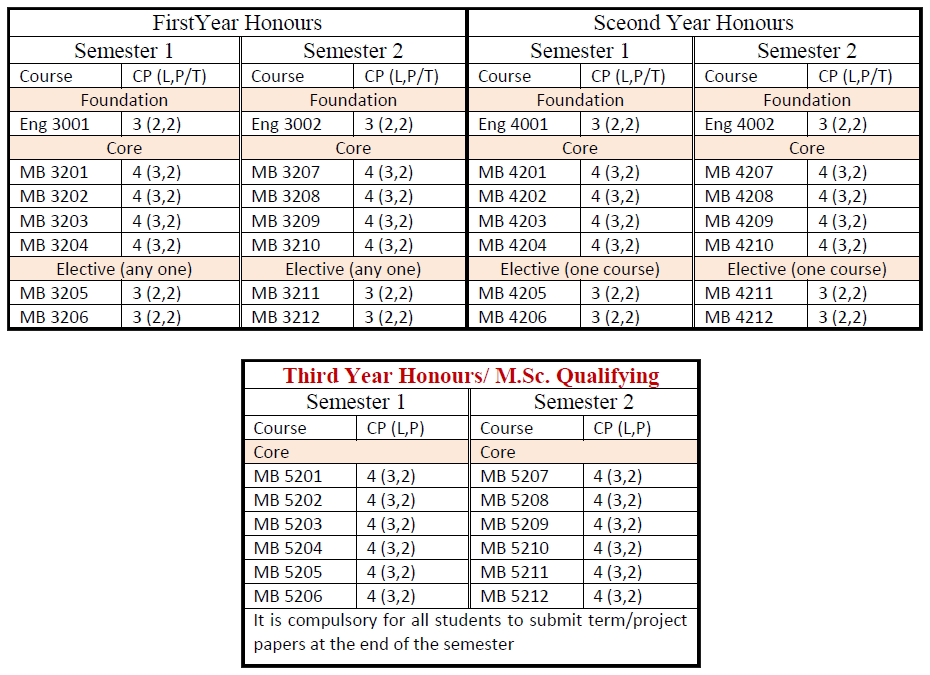Microbiology
Curriculum
B.Sc. in Microbiology

B.Sc. (Honours) in Microbiology
Students who passed second year with GPA ≥ 4 are eligible to attend B.Sc. (Honours) classes for three more years. After finished successfully, they earn B.Sc. (Hons) degree majoring in Microbiology.

Course Descriptions
The purpose of this module is to introduce microbiology to the beginners. It consists of history and scope of microbiology; classification of microorganisms; study of microbial structure: microscopy and specimen preparation; prokaryotic cell structure and function; and eukaryotic cell structure and function.
This course provides to understand the nature of microorganisms in our environment, beneficial activities in nature and importance of microorganisms for human.
This module deals with bacterial taxonomy; cell structures, virulence factors and toxins; bacterial growth; bacterial genetics; Gram-positive and negative bacteria; acid-fast bacteria; and bacteria without cell walls.
This course provides to know the geological timescale and overview of the history of life on earth and overview of microbial evolution.
This course mainly emphasize on the main groups of Microorganisms for higher plants, especially discuss the importance of plant viruses, bacteria and fungi.
This module concerns with foundations of microbial ecology; microbial interactions; nutrient cycling interactions; the physical environment; microbial ecology and its methods; microorganisms in aquatic environments; and microorganisms in terrestrial environments.
The module familiarizes students with Prokaryotic Diversity of Bacteria and Archaea; Eukarya: Protozoa; and Viruses.
This course provides the general characters of plant viruses and plant diseases, caused by virus and economical importance of plant viruses.
This module firstly introduces students with General Characteristics of virus. Then, students will learn Bacteriophages and Viruses of Eukaryotes.
This module consists of such topics as Role of ATP in Metabolism, Enzymes, Glycolytic Pathway, Tricarboxylic Acid Cycle, Electron Transport Chain, Oxidative Phosophorylation, Yield of ATP in Glycolysis, Aerobic and Anaerobic Respiration, Oxidation of Inorganic Molecules, Fermentations, Gluconeogenesis and Entner-Doudoroff Pathway.
This course provides the knowledge of microalgal diversity, their uses and microalgal culture techniques.
This module reveals evolution of earth and earliest life forms, primitive organisms and metabolic strategies, primitive organisms and molecular coding, eukaryotes and organelles, evolutionary chronometers, ribosomal RNA sequences and evolution, microbial phylogeny as revealed by ribosomal RNA sequencing, and characteristics of the primary domains.
This module provides the general characters of plant viruses and plant diseases, caused by virus and economical importance of plant viruses.
The word “yeast” comes from Old English gist, gyst, and from the Indo-European root yes-, meaning boil foam or bubble. Yeast microbes are probably one of the earliest domesticated organisms. This course provides the knowledge of Yeast history, growth and cell cycle, metabolism and its application.
This module firstly introduces about Microbial Physiology to students. Then, it familiarises students with Basic Concepts of Metabolism, Common Metabolic Pathways, Energy Production and Metabolite Transport, and finally with Microbial Growth.
This module concerns with The Nature of Molecules; Genes: Structure, Replication and Mutation; Genes: Expression and Regulation; and Microbial Recombination and Plasmids.
Macromolecules and genetic information, DNA structure, genetic element of microorganism are detail discuss in this course.
Research is a systematic inquiry to describe, explain, predict and control the observed phenomenon. Research methodology is a systematic use of methods to analyze or research subject. It includes observations and formation of the topic, hypothesis, conceptual definition, operational definition, gathering of data, analysis of data, data Interpretation, test, revising of hypothesis and conclusion.
After finishing this module, students will be able to know importance of research in science, how to formulate and handling problems in research, how to construct research tools and framework, how to survey literature, how to design research, how to analyze, interpret and present the data, how to write reports and research papers.
After finishing this module, students will be able to know importance of research in science, how to formulate and handling problems in research, how to construct research tools and framework, how to survey literature, how to design research, how to analyze, interpret and present the data, how to write reports and research papers.
This module includes such topics as General Characteristics of Fishes and Prawns; Morphology of Fishes and Prawns; Fishes/Prawns Diseases and Medicine; and Aquatic Pollution.
This module firstly introduces students with Immunology. Then, students will learn on Defensive Mechanism; Non-Specific and Specific Immunity; Antigen-Antibody Reactions; and Transplanting Immunology.
This module familiarizes students with diseases that acquired through the respiratory tract, the alimentary tract, the genitourinary tracts, and the skin. Then, students will learn about nosocomial infections.
Pollution is the introduction of contaminants into the natural environment that cause adverse change. Pollution can take the form of chemical substances or energy, such as noise, heat or light. Any Process that uses microorganisms, fungi, green plants Or their enzymes to break down harmful chemicals and pollutant in order to return the environment to its original condition. Bioremediation are mainly discussed in this course.
Agricultural microbiology is a branch of microbiology dealing with plant-associated microbes and plant and animal diseases. It also deals with the microbiology of soil fertility, such as microbial degradation of organic matter and soil nutrient transformation.
This module reveals such topics in Biostatistics as Definition, Scope and Limitations; Sampling Methods; Collection of Data, Classification and Tabulation; Frequency Distribution; Diagrammatic and Graphical Representation; Measures of Central Tendency; Measure of Dispersion; Probability; Correlation and Regression.
Air microbiology is the study of living microbes which are suspended in the air. These microbes are referred to as bioaerosols. Though there are significantly less atmospheric microorganisms than there are in oceans and in soil, there is still a large enough number that they can affect the atmosphere.
Pharmaceutical microbiology is an applied branch of microbiology. It involves the study of microorganisms associated with the manufacture of pharmaceuticals e.g. Insulin and human growth hormone.
This module deals with Microbial Ecology; Terrestrial Microbiology; Aquatic Microbiology; Microbes as Pollutants; and Microbes as Fighters of Pollution.
Microbial biotechnology is defined as any technological application that uses microbiogial systems, microbial organisms, or derivatives thereof, to make or modify products or processes for specific use.
By learning this module, students will acquire detailed knowledge on Food Spoilage; Food Preservation Method; Chemical Preservation; Microorganism Growth in Food; Microbial Growth and Food Spoilage; Controlling Food Spoilage; and Food-Borne Diseases
Industrial microbiology is an area of microbiology which deals with screening, improvement and exploitation of microorganisms for the production of various useful end products on large scale.
The purpose of this module is students enable to learn Introduction on Biophysics; Physical Quantities and their Units; Chemical Bonds and Molecular Interactions; Thermodynamic Principles; Chemical Reactions and Redox Reactions; Bioenergetics; Photobiology; Bioluminescence; Membrane Conductivity; Labeling Techniques; and Instrumentation.
This course provides the diversity of fungi and their application on agriculture.
This course provide the evolution of microbiology and microorganisms, microscopic methods for observing microorganisms, organization, structure and metabolism of microorganisms and microbial energetic.
Symbiosis is close and often long-term interaction between two different biological species. In this course describe the symbiosis of algae, bacteria, fungi, fungi and insect in detail.
This module covers Introduction on Microbiology and Medicine; Pathogenesis of Infectious Diseases; Pathogenic and Commensal Bacteria; Epidemiology and Public Health Microbiology; Public Health Measures for the Control of Epidermis; and Pathogenic or Infections Diseases.
The purpose of this module is students enable to learn Bacterial Diseases of Domestic Animals; Viral Diseases of Domestic Animals and Parasitic Diseases of Domestic Animals.
By this module, students able to know more about the Definition of Blood; Determination and Calculation of Blood Cells; Bloods Disorders; Human Blood Group Systems; and Blood Banking.
This course describes the relation between nutrition and growth of microorganisms and some methods to control of microorganisms.
This course provides to understand the metabolism and enzyme of microorganism, application of microbial enzyme in food and medicine in detail.
Eutrophication is ecosystem’s response to the addition of artificial or natural nutrients, mainly phosphates, through detergents, fertilizer, or sewage, to an aquatic system. In this course, ecological effect of eutrophication in standing water, growth and impact of algal blooming and control of blue-green algae are discuss in detail.
This module composed of two main portions: Recombinant DNA Technology and Microbial Genomics.
The purpose of this module is students enable to know Isolation of Pathogens from Clinical Specimens; Growth-Dependent Identification Methods; Testing Cultures for Antibiotic Sensitivity; Immunodiagnostics; Agglutination; Immunoelectron Microscopy; Fluorescent Antibodies; Enzyme-linked Immunosorbent Assay and Radioimmunoassay; Immunoblot Procedures; Nucleic Acid Probes in Clinical Diagnostics; Diagnostic Virology; and Safety in the Clinical Laboratory.
This module deals with the Development of Diseases; Bacterial Diseases of Aquatic Animals; Viral Diseases of Aquatic Animals; and Parasitic Diseases of Aquatic Animals.

